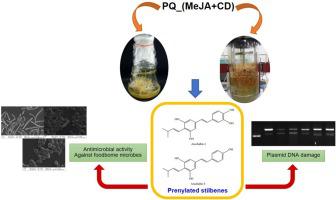Journal of Biotechnology ( IF 4.1 ) Pub Date : 2020-12-28 , DOI: 10.1016/j.jbiotec.2020.12.006 Nichanan Eungsuwan 1 , Phadtraphorn Chayjarung 1 , Jintana Pankam 1 , Vijakhana Pilaisangsuree 1 , Pakwuan Wongshaya 1 , Anupan Kongbangkerd 2 , Chayaphon Sriphannam 1 , Apinun Limmongkon 1

|
Obtaining large-scale hairy root cultures is a major challenge to increasing root biomass and secondary metabolite production. Enhanced production of stilbene compounds such as trans-resveratrol, trans-arachidin-1 and trans-arachidin-3 was achieved using an elicitor treatment procedure. Two different hairy root inoculum densities were investigated and compared between shake flask and bioreactor cultures. The lowest growth index was observed using a 20 g/L inoculum size in the bioreactor, which differed significantly from bioreactor of 5 g/L. Increasing the hairy root inoculum size from 5 g/L to 20 g/L in both the shake flask and bioreactor significantly improve antioxidant activity, phenolic content and stilbene compound levels. The highest ABTS and FRAP antioxidant activity, and levels of total phenolic compounds, trans-arachidin-1 and trans-arachidin-3 in the crude extract were demonstrated in shake flask cultures with a 20 g/L inoculum after elicitation for 72 h. The minimum inhibitory concentrations (MICs) of the crude extract to inhibit growth of foodborne microbes, S. aureus, S. typhimurium and E. coli, were 187.5, 250 and 500 μg/mL, respectively. This was due to the ability of the crude extract to disrupt the cell membrane, as observed by scanning electron microscopy (SEM) showing ruptured pores on the S. aureus and S. typhimurium cell surfaces. Moreover, the E. coli cell division process could be inhibited by the crude extract, which promoted an increase in cell size. A DNA nicking assay indicated that a 50 μg/mL concentration of the crude extract caused plasmid DNA damage that might be due to a genotoxic effect of the pro-oxidant activity of the crude extract.
中文翻译:

与生物反应器相比,摇瓶中诱导的花生毛根培养物的反式白藜芦醇、反式花生四烯酸 1 和反式花生四烯酸 3 的产生和抗菌活性
获得大规模的毛状根培养物是增加根生物量和次生代谢物产量的主要挑战。提高二苯乙烯化合物的产量,例如反式白藜芦醇、反式花生四烯酸 1 和反式-arachidin-3 是使用诱导剂处理程序获得的。研究了两种不同的毛状根接种物密度,并在摇瓶和生物反应器培养物之间进行了比较。在生物反应器中使用 20 g/L 的接种量观察到最低的生长指数,这与 5 g/L 的生物反应器显着不同。在摇瓶和生物反应器中将毛状根接种物的大小从 5 g/L 增加到 20 g/L,可显着提高抗氧化活性、酚类含量和二苯乙烯化合物水平。最高的 ABTS 和 FRAP 抗氧化活性,以及总酚类化合物、反式花生四烯酸 1 和反式的水平粗提物中的 -arachidin-3 在摇瓶培养中得到证实,接种量为 20 g/L,诱导 72 小时后。粗提物抑制食源性微生物、金黄色葡萄球菌、鼠伤寒沙门氏菌和大肠杆菌生长的最小抑制浓度 (MIC)分别为 187.5、250 和 500 μg/mL。这是由于粗提取物能够破坏细胞膜,正如通过扫描电子显微镜 (SEM) 所观察到的那样,金黄色葡萄球菌和鼠伤寒沙门氏菌细胞表面上有破裂的孔。此外,大肠杆菌粗提物可以抑制细胞分裂过程,从而促进细胞大小的增加。DNA 切口分析表明,50 μg/mL 浓度的粗提取物会导致质粒 DNA 损伤,这可能是由于粗提取物的促氧化活性的基因毒性作用所致。



























 京公网安备 11010802027423号
京公网安备 11010802027423号